语言学第四章chapter4 Syntax
- 格式:ppt
- 大小:833.50 KB
- 文档页数:60
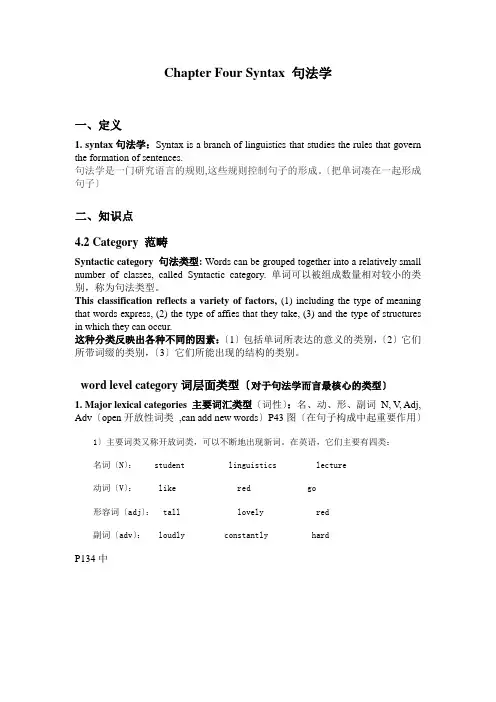
Chapter Four Syntax 句法学一、定义1. syntax句法学:Syntax is a branch of linguistics that studies the rules that govern the formation of sentences.句法学是一门研究语言的规则,这些规则控制句子的形成。
〔把单词凑在一起形成句子〕二、知识点4.2 Category 范畴Syntactic category 句法类型: Words can be grouped together into a relatively small number of classes, called Syntactic category. 单词可以被组成数量相对较小的类别,称为句法类型。
This classification reflects a variety of factors, (1) including the type of meaning that words express, (2) the type of affies that they take, (3) and the type of structures in which they can occur.这种分类反映出各种不同的因素:〔1〕包括单词所表达的意义的类别,〔2〕它们所带词缀的类别,〔3〕它们所能出现的结构的类别。
word level category词层面类型〔对于句法学而言最核心的类型〕1. Major lexical categories 主要词汇类型〔词性〕:名、动、形、副词N, V, Adj, Adv〔open开放性词类,can add new words〕P43图〔在句子构成中起重要作用〕1〕主要词类又称开放词类,可以不断地出现新词。
在英语,它们主要有四类:名词〔N〕: student linguistics lecture动词〔V〕: like red go形容词〔adj〕: tall lovely red副词〔adv〕: loudly constantly hardP134中2. Minor lexical categories 次要词汇类型〔词性〕:限定、程度、量词、助动、介、代、连、叹Det, Deg, Qual, Aux, Prep, Pron, Conj, Int 〔close封闭性词类, words are fixed不添加新词〕P43图2〕次要词类又称闭合词类。
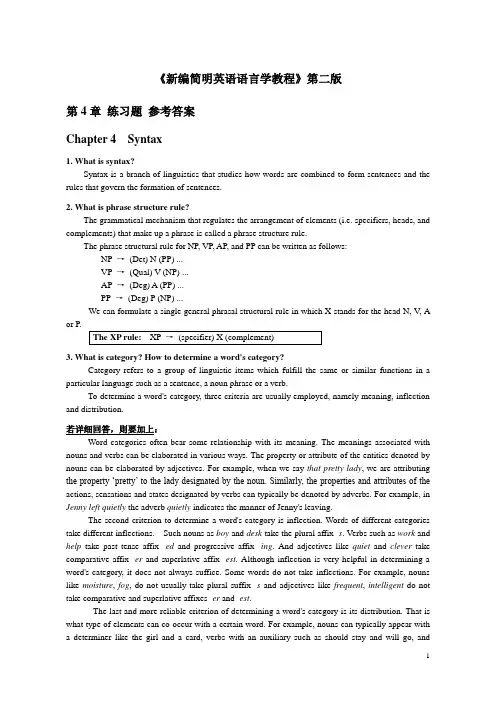
《新编简明英语语言学教程》第二版第4章练习题参考答案Chapter 4 Syntax1. What is syntax?Syntax is a branch of linguistics that studies how words are combined to form sentences and the rules that govern the formation of sentences.2. What is phrase structure rule?The grammatical mechanism that regulates the arrangement of elements (i.e. specifiers, heads, and complements) that make up a phrase is called a phrase structure rule.The phrase structural rule for NP, VP, AP, and PP can be written as follows:NP →(Det) N (PP) ...VP →(Qual) V (NP) ...AP →(Deg) A (PP) ...PP →(Deg) P (NP) ...We can formulate a single general phrasal structural rule in which X stands for the head N, V, A or P.3. What is category? How to determine a word's category?Category refers to a group of linguistic items which fulfill the same or similar functions in a particular language such as a sentence, a noun phrase or a verb.To determine a word's category, three criteria are usually employed, namely meaning, inflection and distribution.若详细回答,则要加上:Word categories often bear some relationship with its meaning. The meanings associated with nouns and verbs can be elaborated in various ways. The property or attribute of the entities denoted by nouns can be elaborated by adjectives. For example, when we say that pretty lady, we are attributing the property ‘pretty’ to the lady designated by the noun. Similarly, the properties and attributes of the actions, sensations and states designated by verbs can typically be denoted by adverbs. For example, in Jenny left quietly the adverb quietly indicates the manner of Jenny's leaving.The second criterion to determine a word's category is inflection. Words of different categories take different inflections. Such nouns as boy and desk take the plural affix -s. Verbs such as work and help take past tense affix -ed and progressive affix -ing. And adjectives like quiet and clever take comparative affix -er and superlative affix -est. Although inflection is very helpful in determining a word's category, it does not always suffice. Some words do not take inflections. For example, nouns like moisture, fog, do not usually take plural suffix -s and adjectives like frequent, intelligent do not take comparative and superlative affixes -er and -est.The last and more reliable criterion of determining a word's category is its distribution. That is what type of elements can co-occur with a certain word. For example, nouns can typically appear with a determiner like the girl and a card, verbs with an auxiliary such as should stay and will go, andadjectives with a degree word such as very cool and too bright.A word's distributional facts together with information about its meaning and inflectional capabilities help identify its syntactic category.4. What is coordinate structure and what properties does it have?The structure formed by joining two or more elements of the same type with the help of a conjunction is called coordinate structures.It has (或写Conjunction exhibits) four important properties:1) There is no limit on the number of coordinated categories that can appear prior to the conjunction.2) A category at any level (a head or an entire XP) can be coordinated.3) Coordinated categories must be of the same type.4) The category type of the coordinate phrase is identical to the category type of the elements beingconjoined.5. What elements does a phrase contain and what role does each element play?A phrase usually contains the following elements: head, specifier and complement. Sometimes it also contains another kind of element termed modifier.The role each element can play:Head:Head is the word around which a phrase is formed.Specifier:Specifier has both special semantic and syntactic roles. Semantically, it helps to make more precise the meaning of the head. Syntactically, it typically marks a phrase boundary.Complement:Complements are themselves phrases and provide information about entities and locations whose existence is implied by the meaning of the head.Modifier:Modifiers specify optionally expressible properties of the heads.6. What is deep structure and what is surface structure?There are two levels of syntactic structure. The first, formed by the XP rule in accordance with the head's subcategorization properties, is called deep structure(or D-structure). The second, corresponding to the final syntactic form of the sentence which results from appropriate transformations, is called surface structure (or S-structure).(以下几题只作初步的的成分划分,未画树形图, 仅供参考)7. Indicate the category of each word in the following sentences.a) The old lady got off the bus carefully.Det A N V P Det N Advb) The car suddenly crashed onto the river bank.Det N Adv V P Det Nc) The blinding snowstorm might delay the opening of the schools.Det A N Aux V Det N P Det Nd) This cloth feels quite soft.Det N V Deg A8. The following phrases include a head, a complement, and a specifier. Draw the appropriatetree structure for each.a) rich in mineralsXP(AP) →head (rich) A + complement (in minerals) PPb) often read detective storiesXP(VP) →specifier (often) Qual +head (read) V +complement (detective stories) NPc) the argument against the proposalsXP(NP) →specifier (the) Det +head (argument) N +complement (against the proposals) PP d) already above the windowXP(VP) →specifier (already) Deg +head (above) P +complement (the window) NPd) The apple might hit the man.S →NP (The apple) + Infl (might) +VP (hit the man)e) He often reads detective stories.S →NP (He) +VP (often reads detective stories)9. The following sentences contain modifiers of various types. For each sentence, first identify the modifier(s), then draw the tree structures.(斜体的为名词的修饰语,划底线的为动词的修饰语)a) A crippled passenger landed the airplane with extreme caution.b) A huge moon hung in the black sky.c) The man examined his car carefully yesterday.d) A wooden hut near the lake collapsed in the storm.10. The following sentences all contain conjoined categories. Draw a tree structure for each of the sentences.(划底线的为并列的范畴)a) Jim has washed the dirty shirts and pants.b) Helen put on her clothes and went out.c) Mary is fond of literature but tired of statistics.11. The following sentences all contain embedded clauses that function as complements of a verb, an adjective, a preposition or a noun. Draw a tree structure for each sentence.a) You know that I hate war.b) Gerry believes the fact that Anna flunked the English exam.c) Chris was happy that his father bought him a Rolls-Royce.d) The children argued over whether bats had wings.12. Each of the following sentences contains a relative clause. Draw the deep structure and the surface structure trees for each of these sentences.a) The essay that he wrote was excellent.b) Herbert bought a house that she lovedc) The girl whom he adores majors in linguistics.13. The derivations of the following sentences involve the inversion transformation. Give the deep structure and the surface structure of each of these sentences. (斜体的为深层结构,普通字体的为表层结构)a) Would you come tomorrow?you would come tomorrowb) What did Helen bring to the party?Helen brought what to the partyc) Who broke the window?who broke the window。
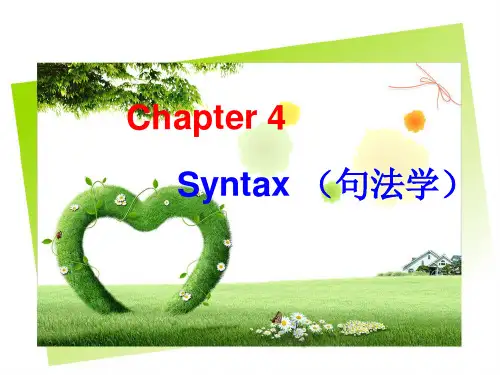
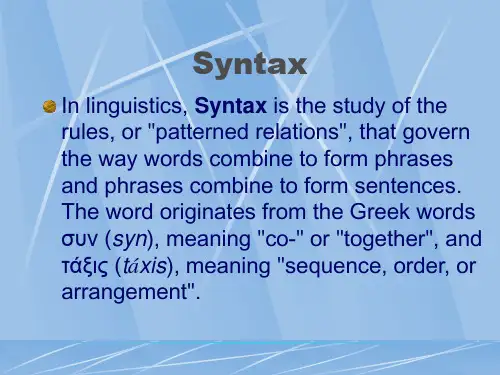
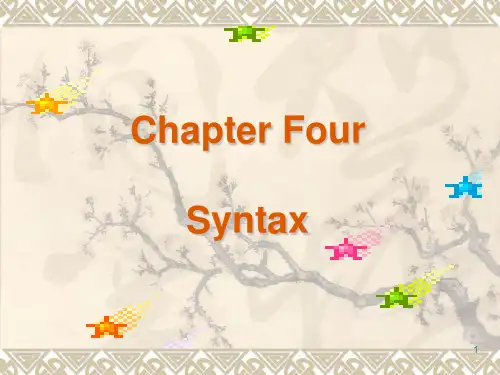

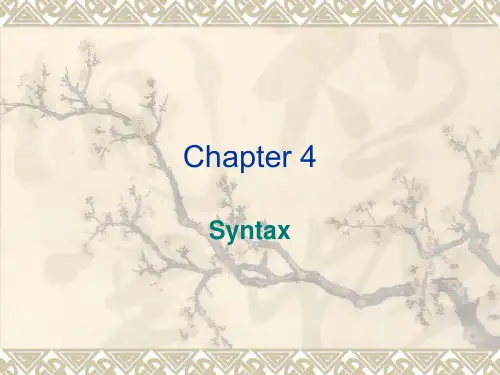
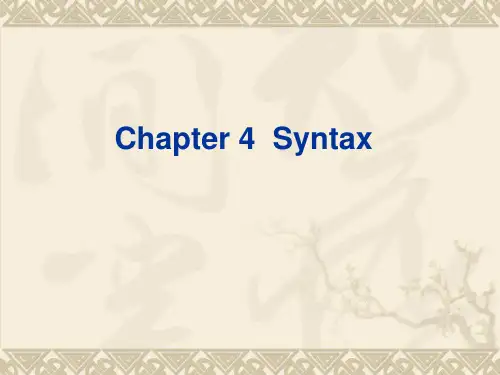
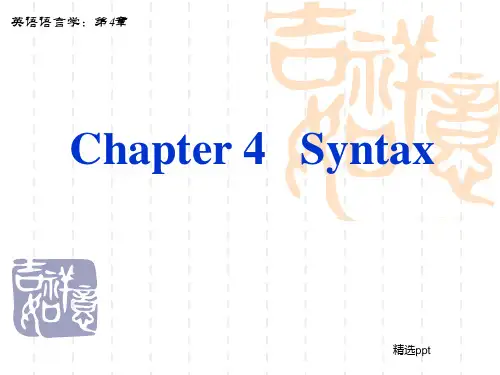
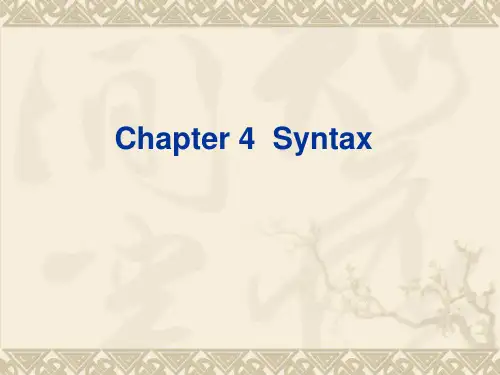
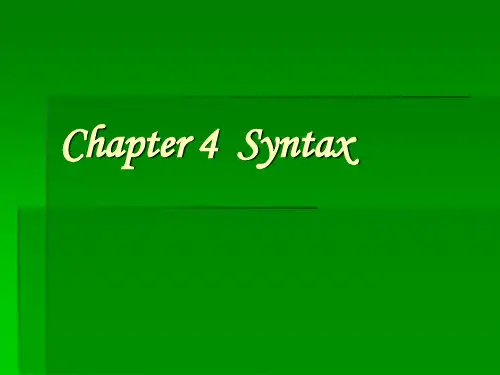
⾃考英语语⾔学Chapter4SyntaxChapter 4 Syntax句法学⼀、本章纲要⼆、本章重点Syntax is a subfield of linguistics that studies the sentence structure of language. (2002,判断;2003名词解释;2007,4选择)1. Syntax as a system rules句法规则系统As a major component of grammar, syntax consists of a set of abstract rules that allow words to be combined with other words to form grammatical sentences.A sentence is considered grammatical when it is in agreement with the grammatical knowledge in the mind of native speakers.Universally found in the grammars of all human languages, syntactic rules comprise the system of internalized linguistic knowledge of a language speaker known as linguistic competence. (2005,33名词解释)The syntactic rules of any language are finite in number, and yet there is no limit to the number of sentences native speakers of that language are able to produce and comprehend.A major goal of linguistics is to show with a consistent and explicit grammatical theory how syntactic rules account for this grammatical knowledge. A theory of grammar must provide a complete characterization of linguistic utterances(⾔语)that speaker implicitly consider well-formed, or grammatical, sequences.1)语⾔学中,句法学是和语⾳学,⾳系学,形态学,语义学等并列平⾏的次系统,主要是来分析研究语⾔的句⼦结构。